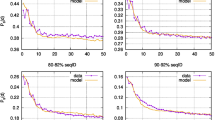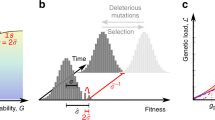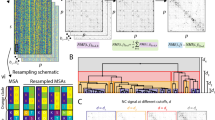Abstract
Much more variation in the rate of protein evolution occurs than is expected by chance1. But why some proteins evolve rapidly but others slowly is poorly resolved. It was proposed, for example, that essential genes might evolve slower than dispensable ones2, but this is not the case3; and despite earlier claims4, rates of evolution do not correlate with amino-acid composition5. A few patterns have been found: proteins involved in antagonistic co-evolution (for example, immune genes3,6, parasite antigens7 and reproductive conflict genes8,9,10) tend to be rapidly evolving, and there is a correlation between the rate of protein evolution and the mutation rate of the gene1,11,12. Here we report a new highly statistically significant predictor of a protein's rate of evolution, and show that linked genes have similar rates of protein evolution. There is also a weaker similarity of rates of silent site evolution (see ref. 13), which appears to be, in part, a consequence of the similarity in rates of protein evolution. The similarity in rates of protein evolution is not a consequence of underlying mutational patterns. A pronounced negative correlation between the rate of protein evolution and a covariant of the recombination rate indicates that rates of protein evolution possibly reflect, in part, the local strength of stabilizing selection.
This is a preview of subscription content, access via your institution
Access options
Subscribe to this journal
Receive 51 print issues and online access
$199.00 per year
only $3.90 per issue
Buy this article
- Purchase on Springer Link
- Instant access to full article PDF
Prices may be subject to local taxes which are calculated during checkout



Similar content being viewed by others
References
Wolfe, K. H. & Sharp, P. M. Mammalian gene evolution: nucleotide sequence divergence between mouse and rat. J. Mol. Evol. 37, 441–456 (1993).
Wilson, A. C., Carlson, S. S. & White, T. J. Biochemical evolution. Ann. Rev. Biochem. 46, 573–639 ( 1977).
Hurst, L. D. & Smith, N. G. C. Do essential genes evolve slowly? Curr. Biol. 9, 747–750 (1999).
Graur, D. Amino-acid composition and the evolutionary rates of protein-coding genes. J. Mol. Evol. 22, 53–62 (1985).
Tourasse, N. J. & Li, W. -H. Selective constraints, amino acid composition, and the rate of protein evolution. Mol. Biol. Evol. 17, 656–664 (2000).
Kuma, K., Iwabe, N. & Miyata, T. Functional constraints against variations on molecules from the tissue-level—slowly evolving brain-specific genes demonstrated by protein-kinase and immunoglobulin supergene families. Mol. Biol. Evol. 12, 123–130 ( 1995).
Hughes, A. L. Circumsporozoite protein genes of malaria parasites (Plasmodium spp.): evidence for positive selection on immunogenic regions. Genetics 127, 345–353 ( 1991).
Tsaur, S. C. & Wu, C. I. Positive selection and the molecular evolution of a gene of male reproduction, Acp26Aa of Drosophila. Mol. Biol. Evol. 14, 544–549 (1997).
Hurst, L. D. & McVean, G. T. Do we understand the evolution of genomic imprinting? Curr. Opin. Genet. Dev. 8, 701–708 (1998).
Wyckoff, G. J., Wang, W. & Wu, C. I. Rapid evolution of male reproductive genes in the descent of man. Nature 403, 304–309 ( 2000).
Makalowski, W. & Boguski, M. S. Synonymous and nonsynonymous substitution distances are correlated in mouse and rat genes. J. Mol. Evol. 47, 119– 121 (1998).
Smith, N. G. C. & Hurst, L. D. The effect of tandem substitutions on the correlation between synonymous and nonsynonymous rates in rodents. Genetics 153, 1395– 1402 (1999).
Matassi, G., Sharp, P. M. & Gautier, C. Chromosomal location effects on gene sequence evolution in mammals. Curr. Biol. 9, 786– 791 (1999).
Silver, L. M. Mouse Genetics (Oxford Univ. Press, Oxford, 1995).
Casane, D., Boissinot, S., Chang, B. H. J., Shimmin, L. C. & Li, W. H. Mutation pattern variation among regions of the primate genome. J. Mol. Evol. 45, 216–226 (1997).
Averof, M., Rokas, A., Wolfe, K. & Sharp, P. M. Evidence for a high frequency of double-nucleotide substitutions. Science 287, 1283–1286 (2000).
Caccio, S. et al. Methylation patterns in the isochores of vertebrate genomes. Gene 205, 119–124 (1997).
Cargill, M. et al. Characterization of single-nucleotide polymorphisms in coding regions of human genes. Nature Genet. 22, 231–238 (1999).
Nordborg, M., Charlesworth, B. & Charlesworth, D. The effect of recombination on background selection. Genet. Res. 67, 159–174 (1996).
Nachman, M. W. & Churchill, G. A. Heterogeneity in rates of recombination across the mouse genome. Genetics 142, 537–548 (1996).
Eyre-Walker, A. Recombination and mammalian genome evolution. Proc. R. Soc. London Ser. B 252, 237–243 ( 1993).
Bernardi, G. The human genome: organization and evolutionary history. Annu. Rev. Genet. 29, 445–476 (1995).
Drouin, R., Holmquist, J. P. & Richer, C. L. High-resolution replication bands compared with morphologic G- and R-bands. Adv. Hum. Genet. 22, 47– 115 (1994).
Bernardi, G. et al. The mosaic genome of warm-blooded vertebrates. Science 228, 953–958 ( 1985).
Galtier, N. & Mouchiroud, D. Isochore evolution in mammals: A human-like ancestral structure. Genetics 150, 1577–1584 (1998).
Duret, L., Mouchiroud, D. & Gouy, M. HOVERGEN—a database of homologous vertebrate genes. Nucleic Acid Res. 22, 2360– 2365 (1994).
Smith, N. G. C. & Hurst, L. D. The causes of synonymous rate variation in the rodent genome: Can substitution rates be used to estimate the sex bias in mutation rate? Genetics 152, 661–673 (1999).
Li, W. -H. Unbiased estimation of the rates of synonymous and nonsynonymous substitution. J. Mol. Evol. 36, 96–99 (1993).
Pamilo, P. & Bianchi, N. O. Evolution of the Zfx and Zfy genes: rates and interdependence between the genes. Mol. Biol. Evol. 10, 271–281 ( 1993).
Acknowledgements
We think W.-H. Li for comments on an earlier version of the manuscript. L.D.H. is funded by The Royal Society.
Author information
Authors and Affiliations
Corresponding author
Supplementary information
Rights and permissions
About this article
Cite this article
Williams, E., Hurst, L. The proteins of linked genes evolve at similar rates. Nature 407, 900–903 (2000). https://doi.org/10.1038/35038066
Received:
Accepted:
Issue Date:
DOI: https://doi.org/10.1038/35038066
This article is cited by
-
Phylogeny and molecular evolution of the DMC1 gene within the StH genome species in Triticeae (Poaceae)
Genes & Genomics (2012)
-
Functional bias in molecular evolution rate of Arabidopsis thaliana
BMC Evolutionary Biology (2010)
-
Gene socialization: gene order, GC content and gene silencing in Salmonella
BMC Genomics (2009)
-
Local Patterns of Nucleotide Polymorphism Are Highly Variable in the Selfing Species Arabidopsis thaliana
Journal of Molecular Evolution (2008)
-
Stable evolutionary signal in a Yeast protein interaction network
BMC Evolutionary Biology (2006)
Comments
By submitting a comment you agree to abide by our Terms and Community Guidelines. If you find something abusive or that does not comply with our terms or guidelines please flag it as inappropriate.



